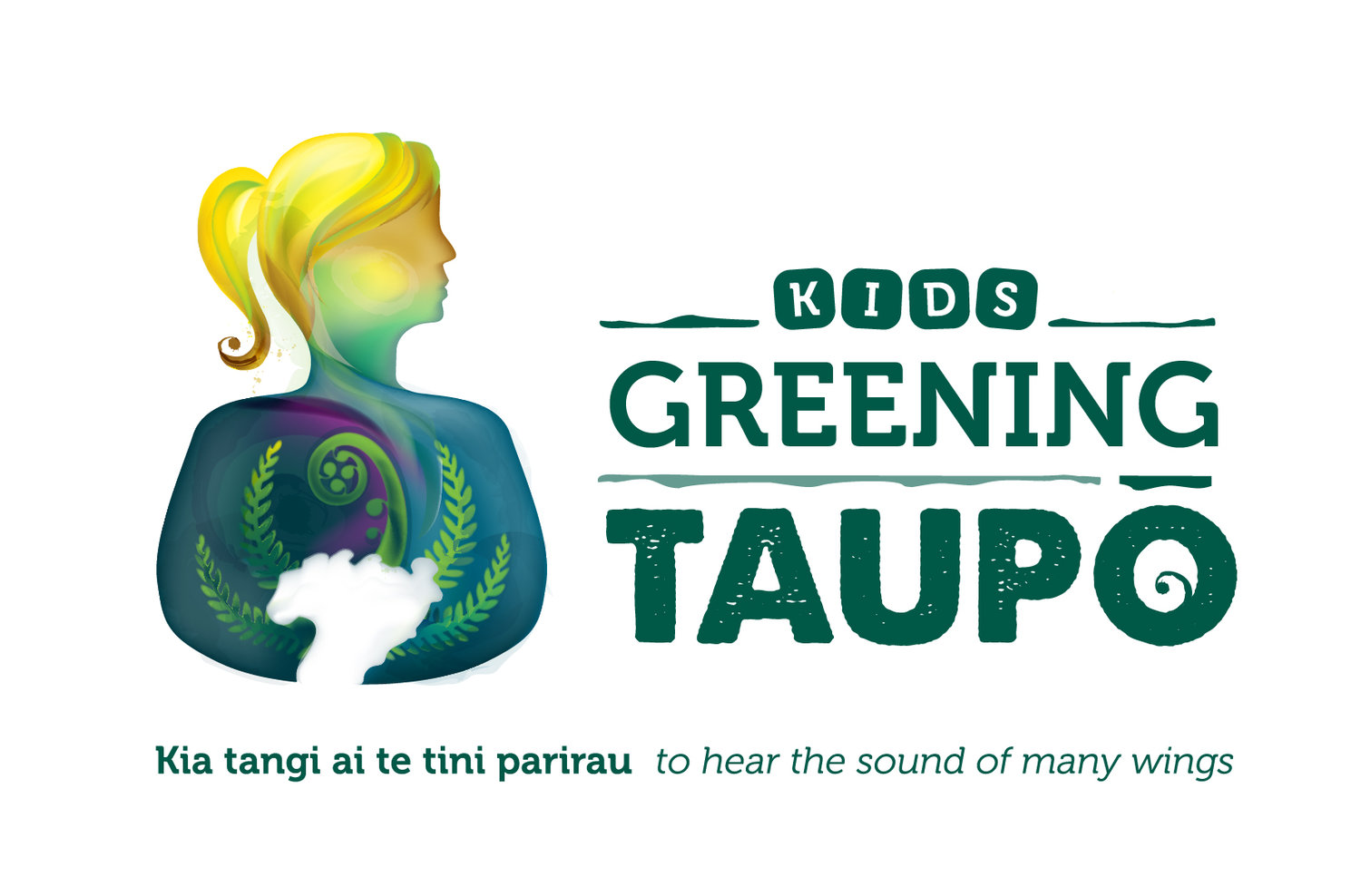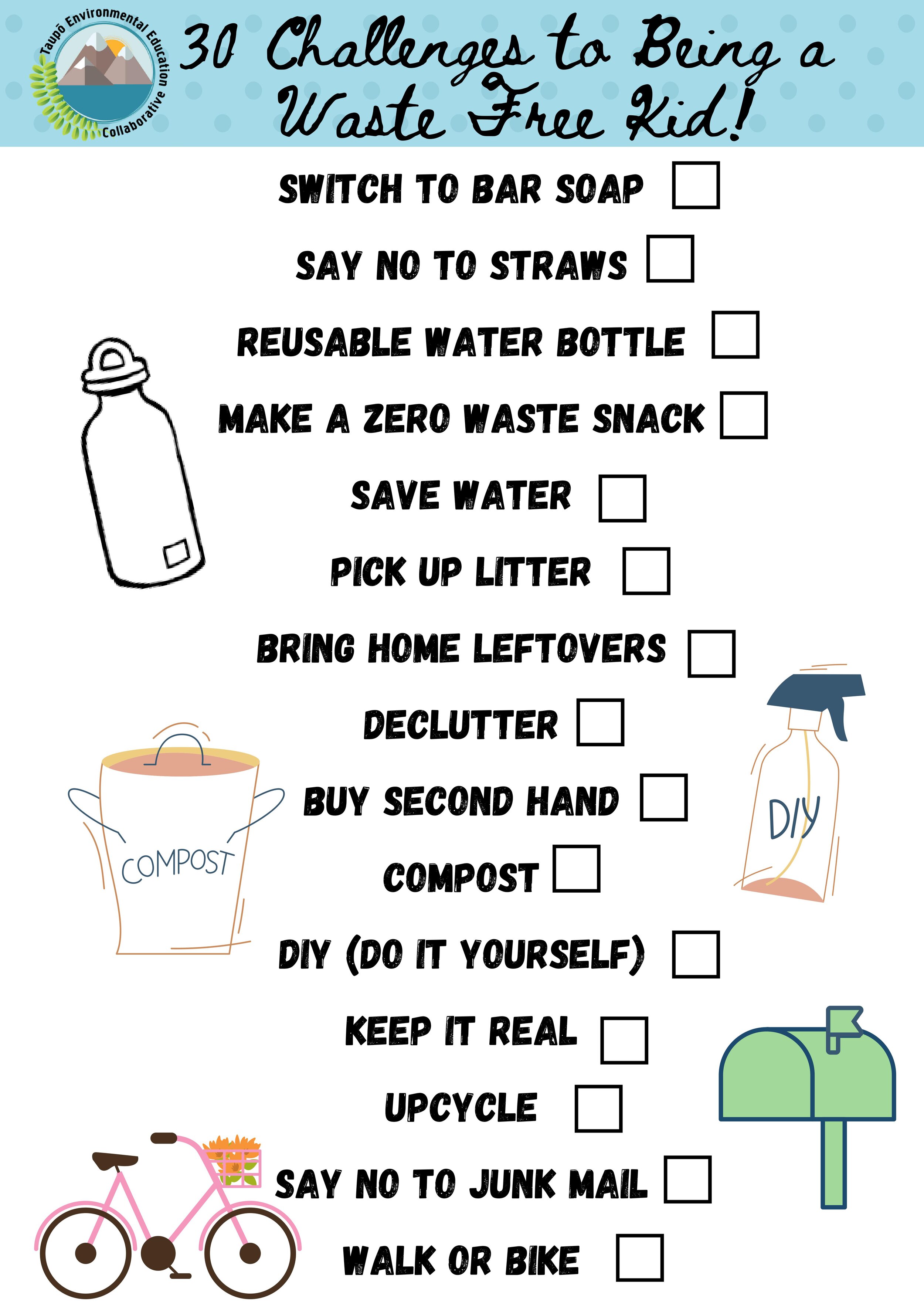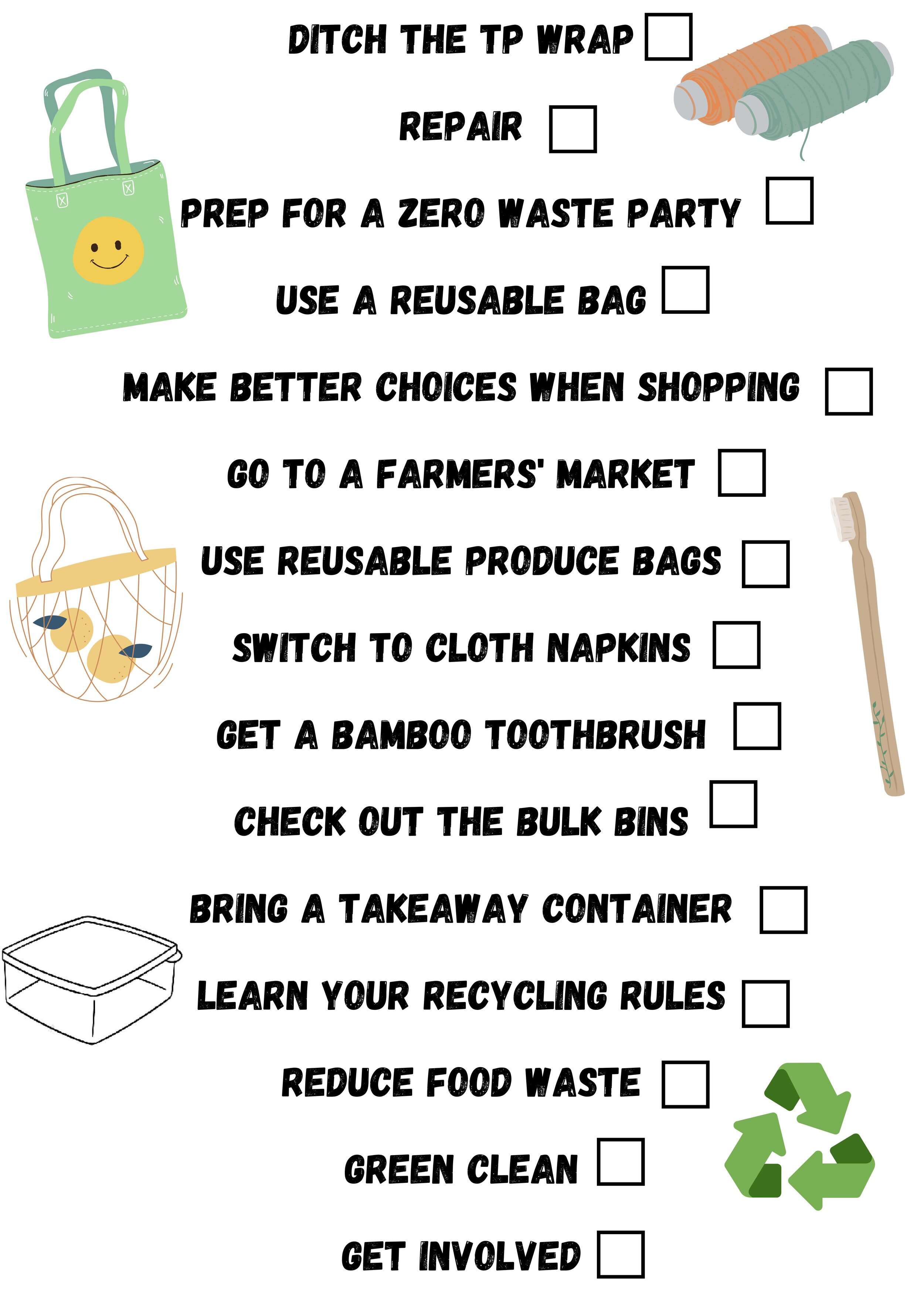30 Challenges to Become a Waste Free Kid!
1. Change to Bar Soap
We use a lot of plastic bottles for hand soap, body wash, shampoo and conditioner. These are easy changes to make. Bar soap has been shown to be just as hygienic as liquid soap, and is often much cheaper.
Challenge: Next time you shop, buy a bar of soap instead of liquid soap in a plastic container. You can often buy bar soap from markets, or bulk stores, with no packaging at all!
2. Say No to Straws
200 million plastic straws are used in New Zealand every year! It's a huge problem because plastic doesn't go away. It only gets smaller and smaller. It's dangerous for marine animals. But, you can help make a change!
Challenge: Next time you're at a restaurant or cafe or order takeaways, order your drink without a straw. "No straw, thanks.” If you really like using straws, buy reusable metal or bamboo straws to use at home, and to carry with you in your bag.
3. Take a Reusable Water Bottle
In NZ, 97 million plastic drink and milk bottles went directly into rubbish instead of recycling bins in a year, and over 100 million water bottles are sent to the dump world wide each day! Plastic has a very low recycle rate. Only 9% is actually recycled. It's much better to bring a reusable bottle.
Challenge: Before you leave your house, make sure you have a reusable bottle with you. Don't forget! Get in the habit of carrying it with you all the time. Use a public drinking fountain to refill it when you’re out and about or ask a local cafe if you can get it refilled there. (https://refillnz.org.nz/ shows locations where you can refill!)
4. Eat Zero Waste Snacks
Most snacks come with a lot of plastic packaging. Think about how all of that plastic adds up.
Challenge: Instead of reaching for a packaged snack try making your own.
Here are some ideas:
- carrot sticks and hummus
- stovetop popcorn
- apple slices in peanut butter
- fruit platter or fruit salad
- homemade biscuits, muffins, bliss balls or muesli bars
5. Save Water
The average person in New Zealand uses 227 litres of water a day. That's a lot of water!
Challenge:
- turn off the water while brushing your teeth
- take shorter showers or only fill the bathtub halfway
6. Pick up Litter
Walking around school or around town, do you see rubbish on the street? Do you know where it will end up? Probably, down a storm drain which will take it out to sea, where it can harm the animals and nature. But, you can fix it!
Challenge: If you see litter, pick it up and put it in the rubbish or recycling bin.
7. Bring Home Leftovers
Food waste is a huge problem! Did you know 50% (half) of our household rubbish in New Zealand is food waste?
Challenge: After you finish your lunch, make sure you pack up any food you have left over and put it in your lunch box. You can eat it as a snack when you get home or eat it tomorrow. You could cut up and freeze left over fruit and vegetables and then make them into a smoothie. Yum!
8. Declutter
So often, we buy things we don’t need. If you have any extra toys or clothes that you don’t need anymore, give them to someone who can use them. You could take them to a second hand shop.
Challenge: Go through the toys in your room this weekend and make a pile of toys that you can give away.
9. Buy Second Hand
By shopping second hand you keep new resources from being used for new items. Shopping second hand allows us to reuse good resources, that would otherwise be waste.
Challenge: Whenever you need to purchase something, it's worth looking to see if you can find it second hand first. Whether that's a piece of clothing, a toy, book, or even craft supplies! Good places to check are Trade Me, Facebook Marketplace, garage sales, consignment stores, and op shops.
10. Start Composting
Composting is super important! If you can't finish all of your food you should compost it. Composting returns food scraps and paper back to the soil where it will break down better than it will in a landfill.
Challenge: Find someone who composts, or has animals that eat scraps, and give them your food scraps. Even better, compost at home! The easiest way to do this is by digging a trench into an area of your garden, pouring your food scraps in, and then covering with dirt. There are plenty of other compost or worm farm systems out there, it’s just a matter of doing research and finding the right one for you!
11. DIY (Do It Yourself!)
A lot of products that you buy are in plastic packaging. Some of these are very easy to make yourself.
Find one packaged product to replace. You can find recipes to make your own soap, face masks, beeswax wraps, shampoo, and detergent. If you can’t make these, bake your own snacks for school lunches.
12. Keep it Real
Disposable products use a lot of resources and are only used for a very short period of time. It's much better to use real items and wash them!
Don't be fooled into thinking disposables save water! Did you know it takes 30 litres of water just to make one paper plate!? Do your part by keeping it real.
Challenge: Say no to disposable items this week and choose reusables instead! You've already started this with water bottles. Keep it going. Fill a reusable bag with some of the following items: tupperware container, cutlery, and a keep cup. Bring this bag with you when you’re out and about so you can avoid getting caught in situations where you need to use single use items.
13. Repair
Repairing is a huge part of the zero waste lifestyle. Just because something is broken, doesn't mean it's time to get something new. Many times these items can be fixed with just a little bit of effort.
Challenge: If you've lost a button on a shirt or have a toy with a broken part, don't throw it out! Repair it. With a few simple tools, it can be as good as new. Ask your parents for help to fix things! You can always look up a YouTube video and learn a new skill together. What can you fix?
14. Walk or Bike
Driving around town uses a lot of petrol. Petroleum is a non-renewable resource. It comes from oil found deep under the ground. Once it is used it cannot be replaced. Our cars turn it into fumes that pollute the air that we breathe. You can help with that by walking or biking short distances instead of driving.
Challenge: Can you walk or bike to the shops? To school? To sports practice? Find a place you can walk or bike instead of driving. Get the whole family on board and plan a day without using the car. Of course, if you live in the country this could be difficult. When you go to town, maybe you could park the car and walk between shops, rather than driving around town.
15. Have a Zero Waste Party
When you organise a party, think about the things that you use. Try to cut out single use plastic. Many party treats, food packaging, and decorations are disposable items.
Challenge: Can you choose food without packaging? Can you use reusable plates and cutlery? Make decorations from paper, or use reusable decorations that you can pack away for next time. Wrap presents using the furoshiki method and fabric, scarves, or tea towels.
16. Use Reusable Bags
New Zealand has done away with plastic bags, but they’ve been replaced by paper bags which aren’t all that better for the environment. In fact, it takes roughly 4 times the energy to create a paper bag than it does to create a plastic one.
Challenge: Practice keeping a reusable bag on you, and some in your car! When you're out shopping, use your own bags. If you forget them, try and carry the items without a bag, or ask for a box. Just remember to recycle the box!
17. Make Better Choices When Shopping
Some products at the supermarket are wrapped in many layers of plastic. If you have a choice between two similar items, choose the one with less packaging.
Challenge: Next time you go shopping think about the packaging on each item that you put in your trolley. Choose glass or metal containers over plastic as these are more easily recycled. Choose items with less plastic and don’t buy things with unnecessary packaging. If you have a choice between buying a large bag of something versus individually wrapped bags, always choose the large bag, it has less packaging!
18. Go to a Farmers Market
Food can travel a long way before it gets to your plate, and sometimes you don't know how it was grown. At the farmers market, you know your food is local and you can ask the farmer how it was grown. How cool is that!?
Challenge: Find a farmers market near you and plan a family trip to visit. Look at all of the beautiful and seasonal produce. Chat with the farmers about how the food is grown. Buy some beautiful looking fruit or vegetables and learn to make a new meal! Remember to take your reusable bags and you won’t have any plastic packaging!
19. Use Reusable Produce Bags
Produce bags at the grocery store and even the farmers market are usually plastic. You're already bringing a reusable bag with you, why not take some reusable produce bags too? These can be bought, easily sewn from scrap fabric, or you can use something already around your house like an extra pillowcase!
Challenge: Next time you are buying groceries, don't bag the produce if it's not necessary. A lot of time it's not. For what is necessary, like large groups of items, use a reusable produce bag.
20. Check out the Bulk Bins
Like we've talked about in previous challenges, it's best to try and avoid unnecessary packaging. You can buy meat and cheese in your own containers from the butcher or deli. You can even buy snacks, grains, and baking products from bulk bins without ANY packaging. Bulk stores like Bin Inn or The Source will let you take your own containers and jars. They also have paper bags that you can use.
Challenge: Check out some local shops and supermarkets to see what you can get package-free! Any bulk bins? What about a butcher counter? Deli counter? Bakery? These are all places you can get food without packaging. Make a list and ask your parents if you can help them buy some of their groceries package free!
21. Recycling Properly
Recycling is great, but it should be viewed as a last resort. We should first refuse unnecessary waste, then reduce what we need, reuse what we have then, and only then, should we recycle. But, it's important to know what's actually recyclable.
Challenge: Go online to your local council website and find out what you can recycle. Can you recycle plastic number 5? What about tetrapak containers? Make sure you and your family are recycling correctly. Remember to remove lids, and to clean your cans, jars, and bottles, or your recycling might just be sent to landfill.
22. Switch to Cloth Napkins
Paper is great because it's compostable, but it still takes a lot of trees to supply everyone with paper serviettes. Instead of a paper serviette, use a cloth napkin. This napkin can be used over and over again instead of being thrown away after one use.
Challenge: Keep some cloth napkins in the car to use when needed. You can use them instead of tissues, serviettes or wipes. Just wash them when they are dirty and then use them again.
23. Use a Bamboo Toothbrush
This is a really easy change to make! Did you know every piece of plastic ever created still exists? There are thousands of toothbrushes washed up each year on beaches across the globe. Don't let your toothbrush be a part of the problem.
Challenge: When it's time for a toothbrush change, switch to a compostable bamboo toothbrush. You can compost the handles, or you can also use the bodies for kindling in the fire.
24. Upcycle
So many neat things can be made out of stuff we throw away. When you turn a waste item into a useful item it's called upcycling. Before you put anything in the recycling bin, you should ask yourself, what can I make with this? Keep in mind, though, that the purpose of upcycling is to reduce waste, not just make something that will then eventually need to get thrown out.
Challenge: What is something that you can upcycle? Cardboard boxes can be turned into storage boxes. Paper printed only on one side can be used to draw on, or folded into an origami creation. Glass jars can become the new holder of a candle, and pallet boards can make a compost bin. Get really creative! There are a ton of fun upcycled crafts on Pinterest.
25. Use Recycled Toilet Paper
Did you know it takes 140 litres of water to make one roll of toilet paper? Globally, the equivalent of 27,000 trees are flushed down the toilet every day. If every house used just one roll of 100% recycled toilet paper a year, it would save thousands of trees.
Challenge: When you buy toilet paper look for some made from 100% recycled content (or sugarcane and bamboo waste products). Try to find toilet paper wrapped in paper, which can be composted, instead of plastic.
26. Say No to Junk Mail
Junk mail, says a report held by Greenpeace, will account for up to 40 per cent of the increase in paper production in the next 10 years. That’s a lot of trees! World paper consumption has gone from 167 million tonnes in 1982 to almost 233 million tonnes in 1989.
Challenge: Make or paint a sign for your letterbox saying:’No Junk Mail Please’
27. Use Reusable Containers for Take-away Food
Take away food containers often can’t be recycled and are only used once before going to landfill. Even the ones that look like cardboard are lined with plastic. These containers are super easy to avoid by remembering to take a container with you when you go out. This can be a Tupperware container, reused container, or even your lunch box!
Challenge: Next time you go out to get take away food, take along some containers. It’s a good idea to keep a couple in your car so you always have one handy.
28. Use Food Scraps
Before you take any food to your compost bin, ask yourself can you eat that? Many times you can!
Challenge: Rethink your food scraps and make a new recipe with your parents. Leftover vegetables could be used to make soup, or blended with chickpeas to make hummus. Bruised or soft fruit could be used to make muffins, cakes or desserts. You can use the leftover fruit from your lunchbox to make a smoothie. There are hundreds of ideas for using up veggie scraps. Find one that you'd like to try this week.
29. Green Clean
Did you know cleaning companies don't have to tell us the ingredients in their products? Many of these hidden ingredients are toxic to the planet and humans. They are not always able to be removed from wastewater before it is released back into our waterways.
Challenge: Make your own all-purpose cleaner and help your parents out this weekend with cleaning duty! It's way easier than it sounds. In a spray bottle, put one part distilled white vinegar and one part warm water. Give it a good shake, and grab a cloth. Spray down the kitchen table and bench, then wipe up with the cloth for a squeaky clean surface! You can find lots of other recipes for cleaning products online.
30. Get Involved
Now that you've made all these changes, it's time to take things one step further.
Challenge: Work on organizing an event this year. There are so many awesome things that can happen through groups acting together.
Here are some ideas for you to get involved with your local community:
- organise a beach/lake clean-up day
- talk with your city/town council about environmentally friendly projects, maybe propose one of your own like a plastic straw ban
- teach others how to buy food the zero waste way
- help others learn new DIY skills
- grow your own food or compost at a community/school garden
How did you go? How many challenges could you and your family tick off the list? Hopefully, you’ll continue many of these challenges in your home long past Plastic Free July!
Teachers: This is a great resource to use for guided reading. It could also be shared as a homework challenge. You could get each child in the class to choose one challenge, and then to make a poster persuading others to take on that challenge. The posters are great to share at assembly, or display in the classroom. This is an awesome immersion activity at the start of a Zero Waste inquiry unit.
Click HERE to download this text as a pdf to print.
Click HERE to download the tick box chart as a pdf to print.


